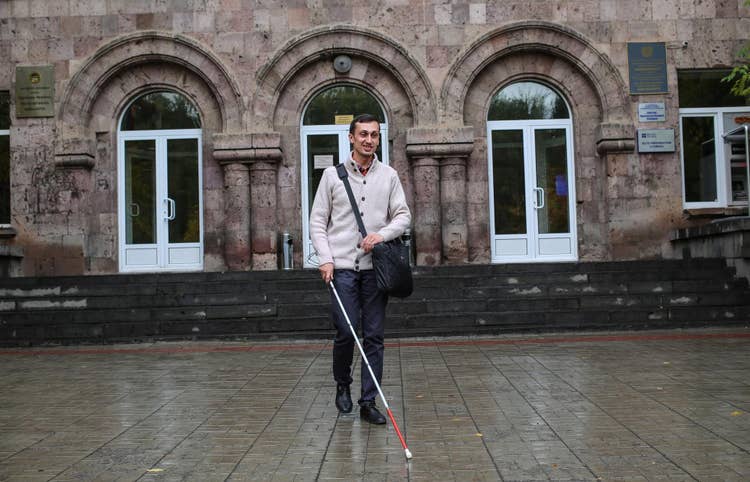Make disability inclusion the norm

In recognition of International Day of Persons with Disabilities, Adobe employee Sipan Asatryan shares his hopes for the future of inclusivity and accessibility.
Today, Sipan Asatryan describes himself as many things: father, husband, son, folkdancer, hiker, world traveler, accessibility engineer at Adobe, and also, blind.
However, growing up in rural Armenia, the message he often received was that his disability limited him and was something to be pitied or ashamed of. But at age 20, his life was transformed when he met educators who showed him how to navigate the world using a white cane—opening up a new chapter of independence and freedom.
In the story he shared during Adobe For All Week, Adobe’s annual internal diversity, equity, and inclusion event, Sipan described how that simple adjustment had an enormous impact, and why it inspired him to work to enable people with disabilities to live independent lives.
We talked with Sipan about why he decided to share his story and why he wants to change the way people think about disability.
Why did you feel it was important to share your story broadly with employees?
I wanted to talk about my experiences and share information about what it’s like to have a disability. I think there are a number of stereotypes about people with disabilities—that they aren’t skilled or that they only have limitations—that are absolutely untrue. My hope is that people will think differently about disability after hearing my story.
What kind of response did you receive from people who listened to your story?
I got comments from people all over the world who said my story inspired them. I have thousands of followers on Facebook in my country, and I also shared the video there and received a very positive response. It was very touching to know my story reached and inspired so many people.
What do you want to change about people’s perception of disability?
I think many people currently have it backwards. I want them to understand that people with disabilities are not limited because of some physical attribute they have. They are limited because others assume there’s not a way to include those who have different abilities.
For instance, I can navigate my surroundings using my hearing, something that sighted people usually can’t do well if they close their eyes. That’s not a limitation; it’s just a different way of doing the same thing. We can include everyone, often just by making a few adjustments.
What kind of adjustments can we make to be more inclusive?
It’s important to consider that exclusion doesn’t have to be the norm. Inclusion might require additional equipment or facilities, but it can also be as simple as changing how you think about a situation.
For example, when I joined my dance group, I could tell people thought my presence was strange at first and were very nervous. They thought they had to speak or interact with me in a special way, but all they had to do was talk to me! The adjustment we made so I could learn the dances was that the teacher showed me the steps by moving my hands to demonstrate. It was that easy.
I want people to know that even though conditions might be different, there’s no reason people with disabilities shouldn’t have equitable access to the same opportunities.
Do you feel public perception about accessibility is changing?
Yes. With social media, TV and movies, and government efforts, people with disabilities are becoming more visible and vocal. I think that has helped spread information and help others understand what we experience. The younger generations, especially, are communicating and learning about these topics more than any before them, and they are more open to making positive changes.
I live in Armenia, and I’m starting to feel that inclusion is now a priority for my country, too. For example, public transportation in my city is changing to be more accessible for people with disabilities, and it makes me glad. I’m hopeful that there will be more changes like this.
What is your vision for the future of inclusion and accessibility?
One of my goals is to forge a path for the next generation of people who are blind, to create a world where people don’t look down on them and where they can live independently. I’ve started working towards this goal as an independent living teacher for people who are blind, and it’s made me so happy when my students—who also became my good friends—enter university, start a career, or just have their own independence. It’s something I want to continue because everyone, including people with disabilities, should have equal rights and equitable opportunities